
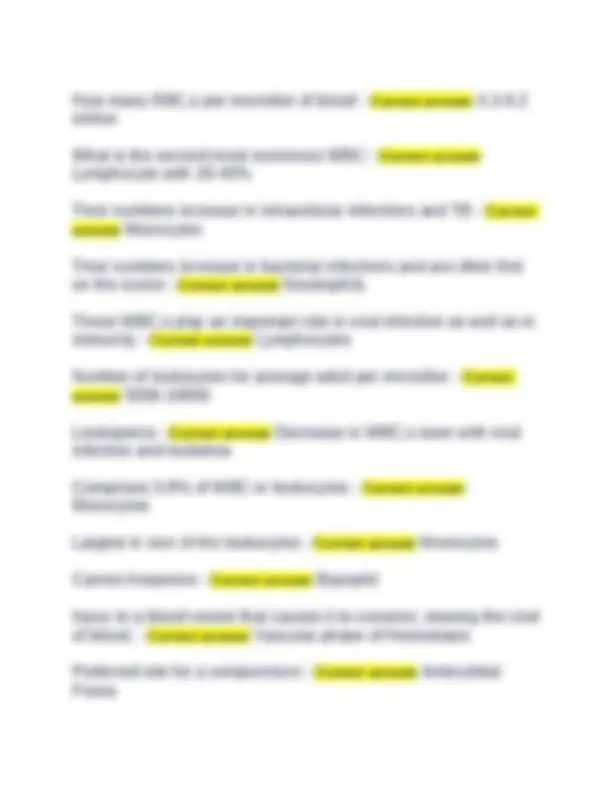
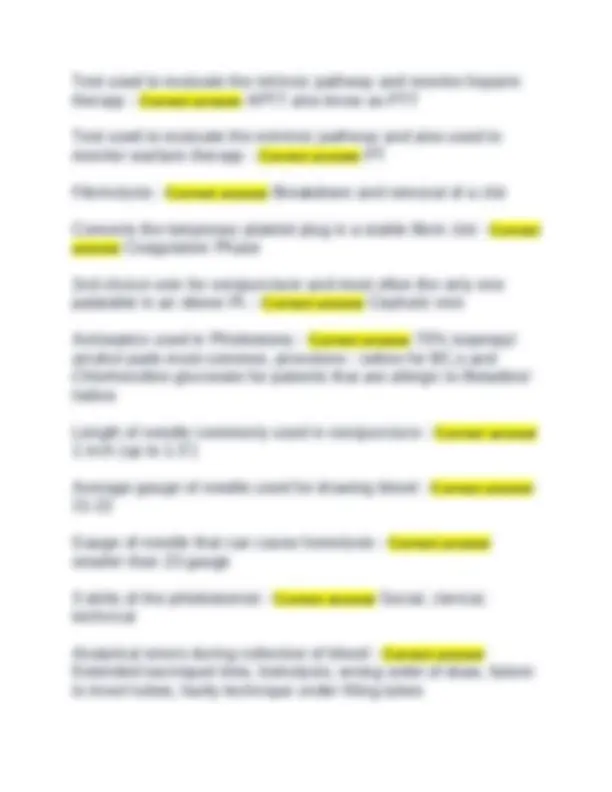
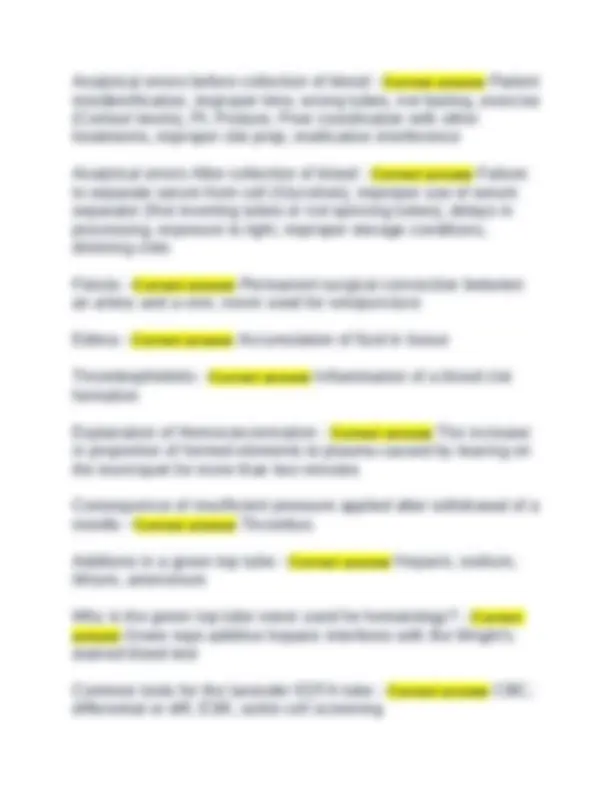
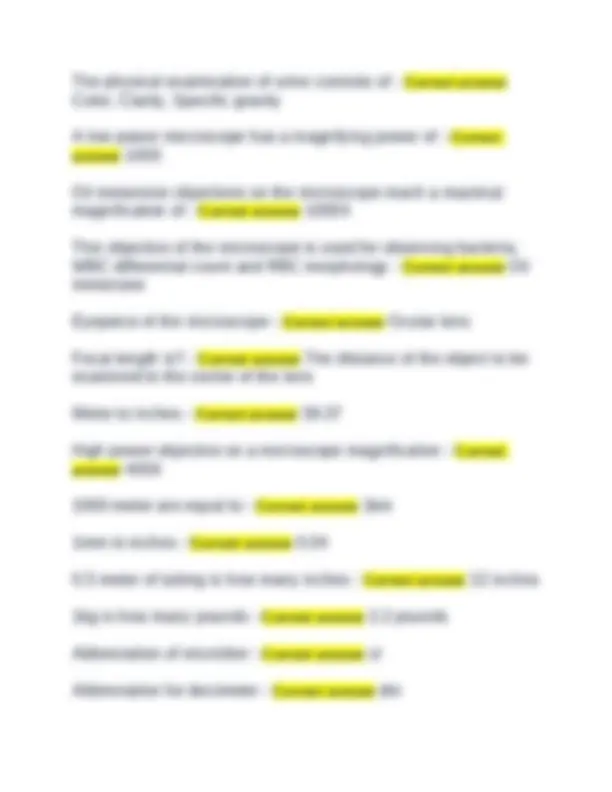
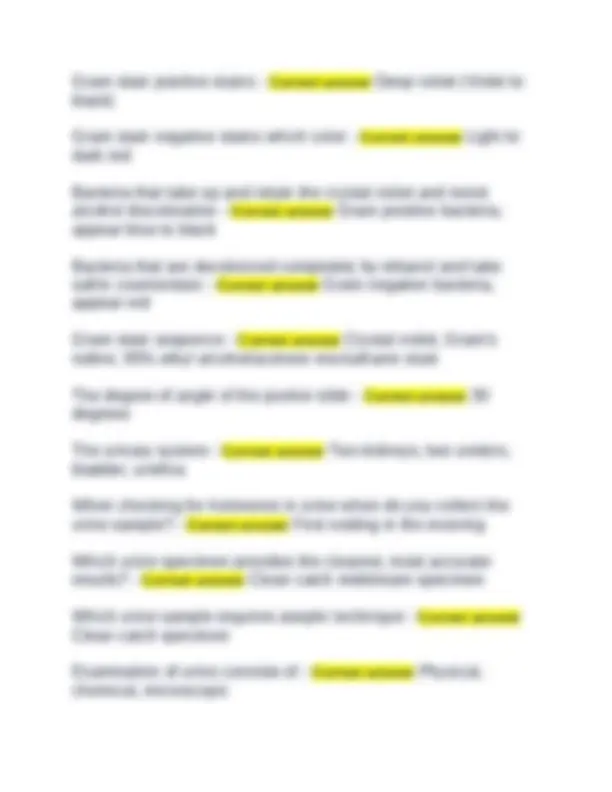
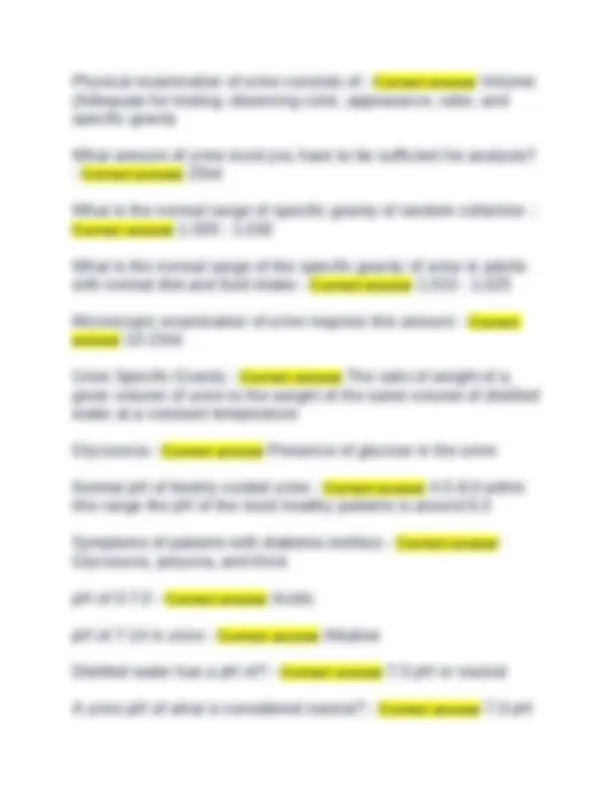
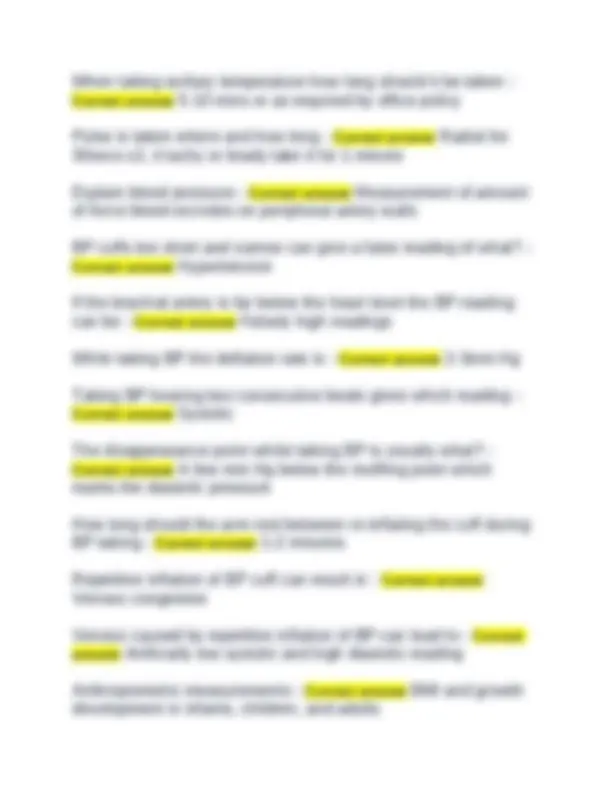
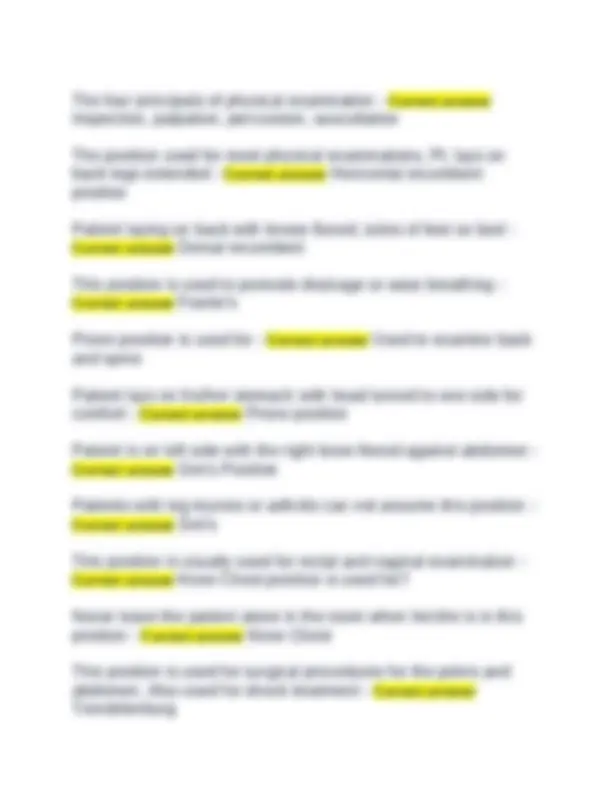
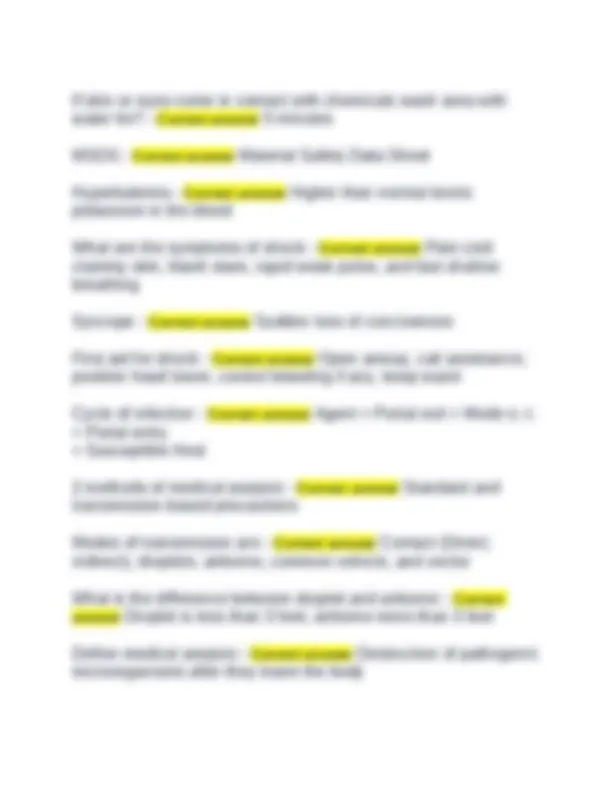
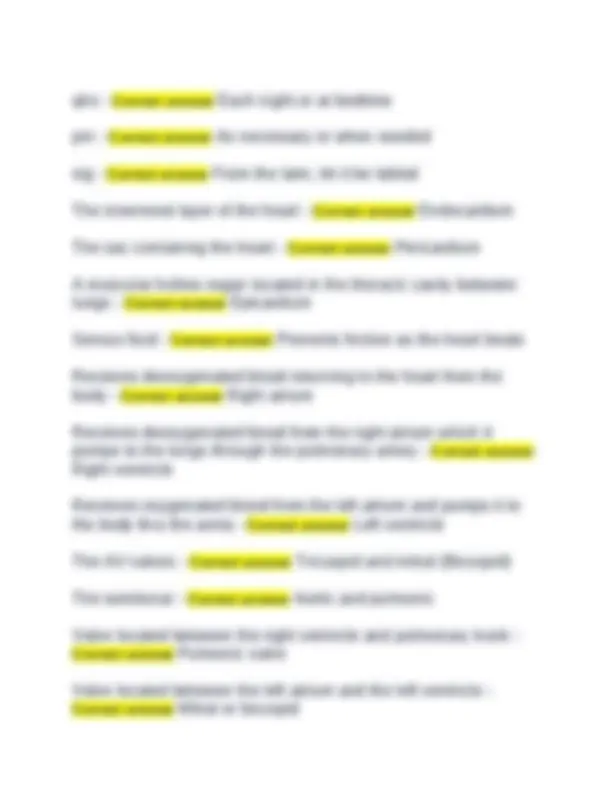
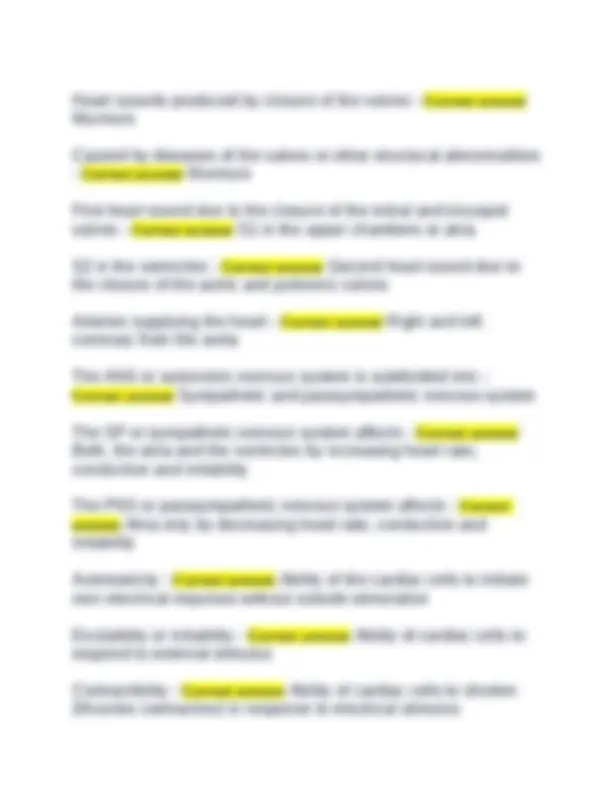
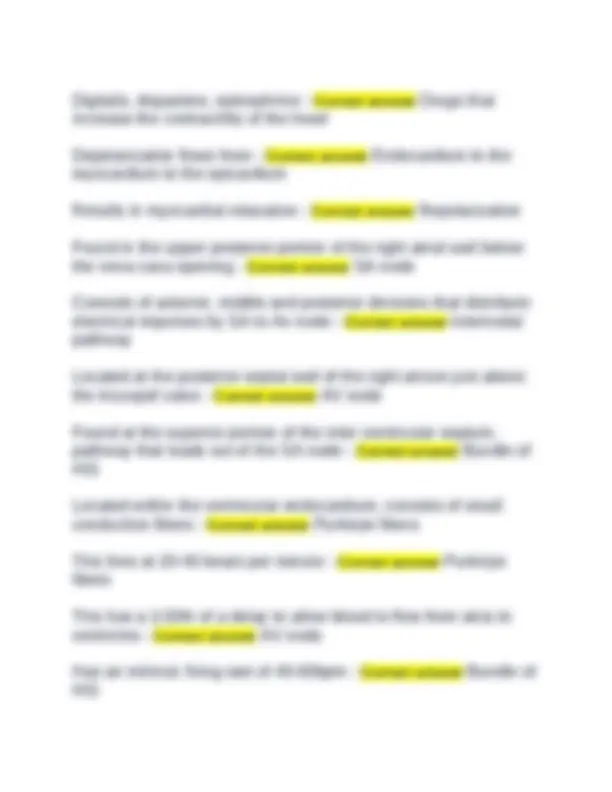
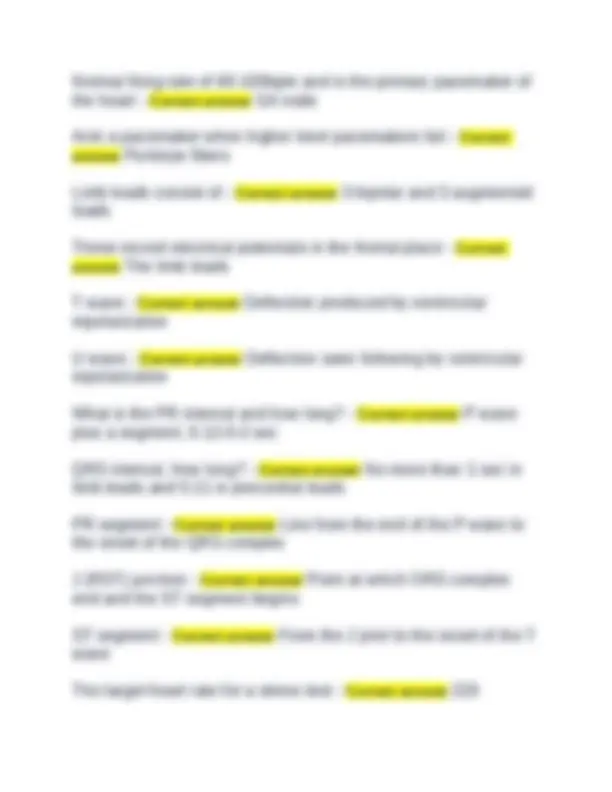
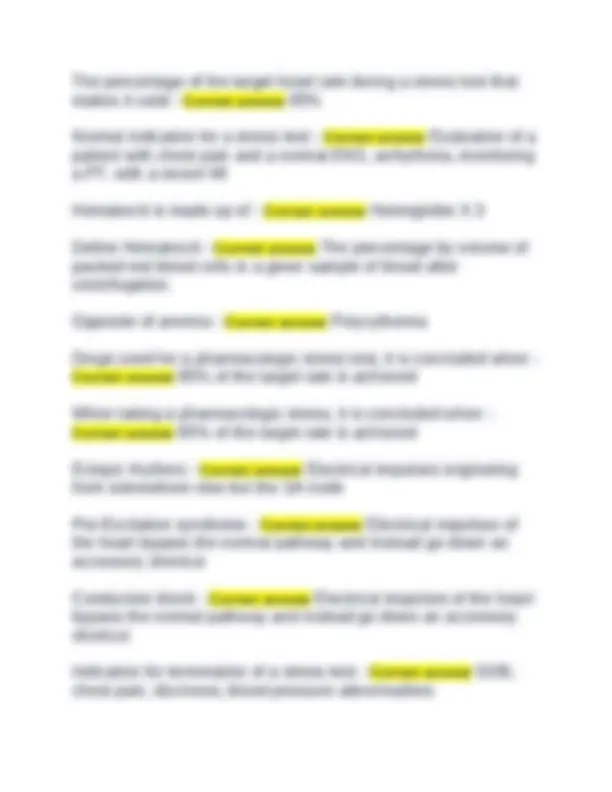
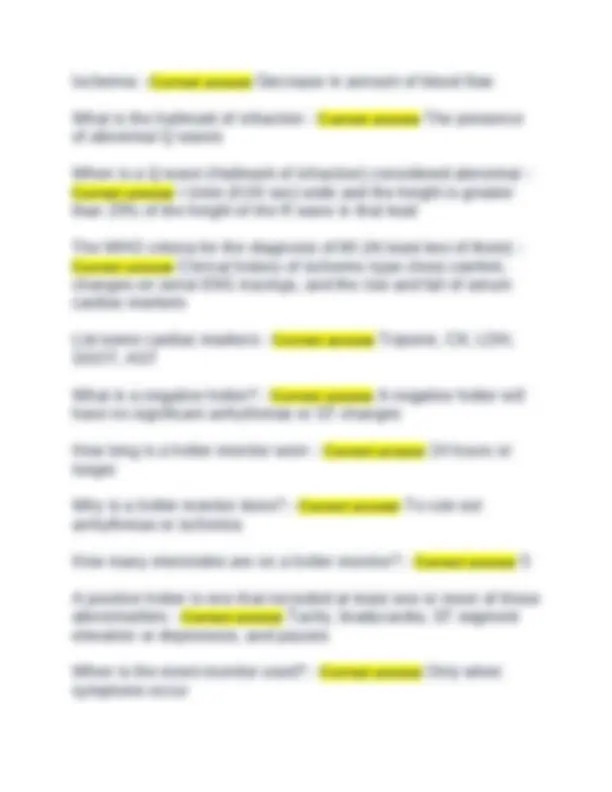
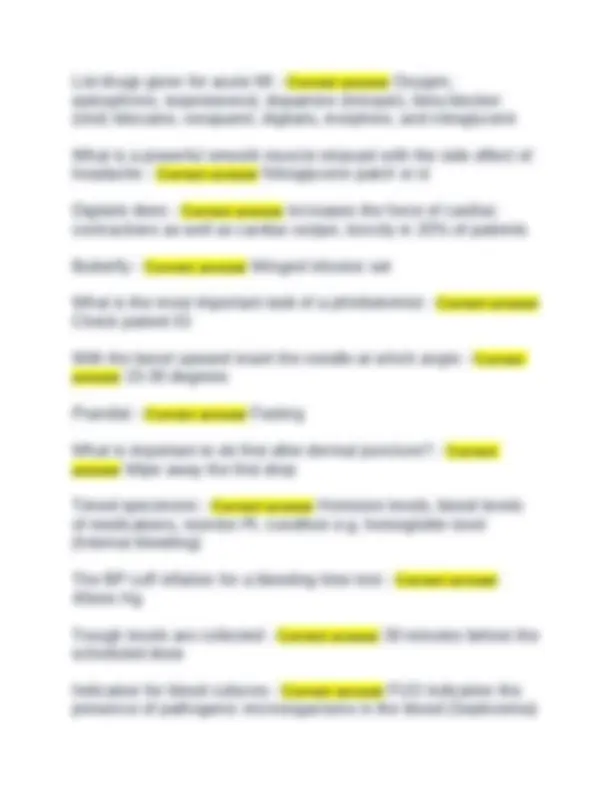
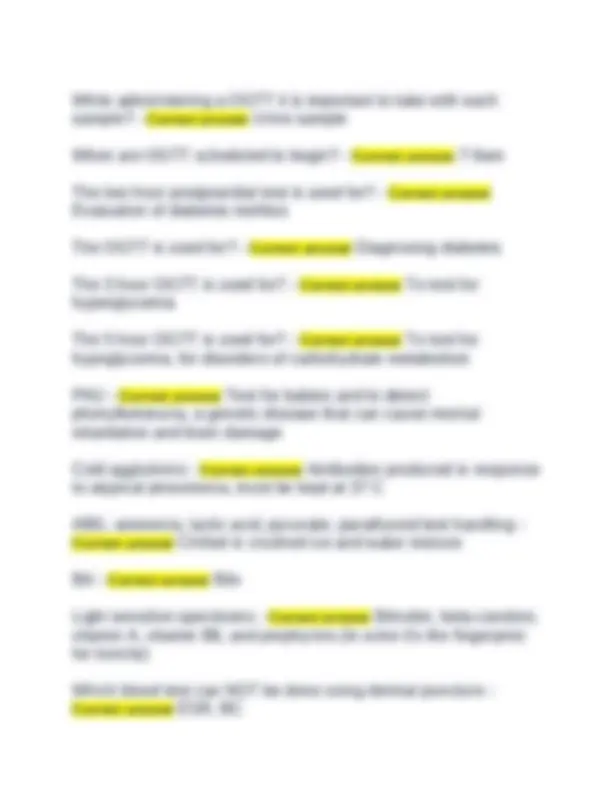
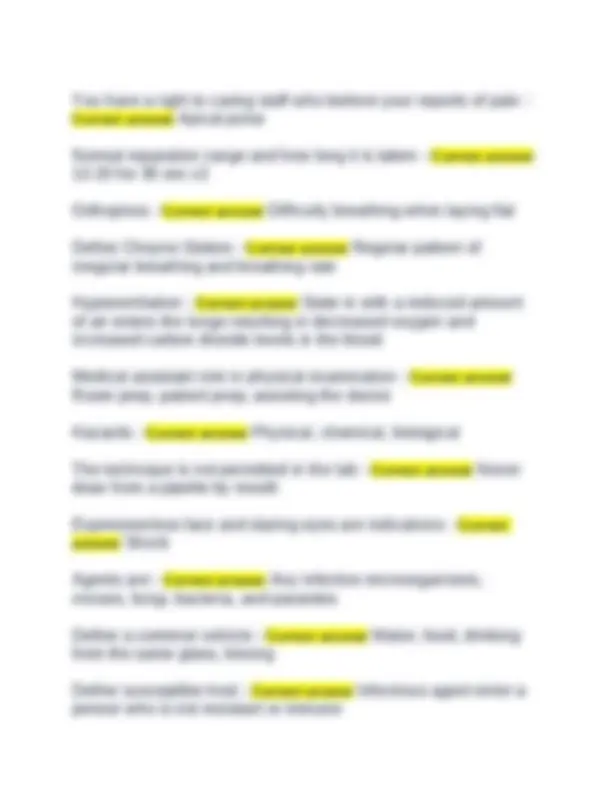
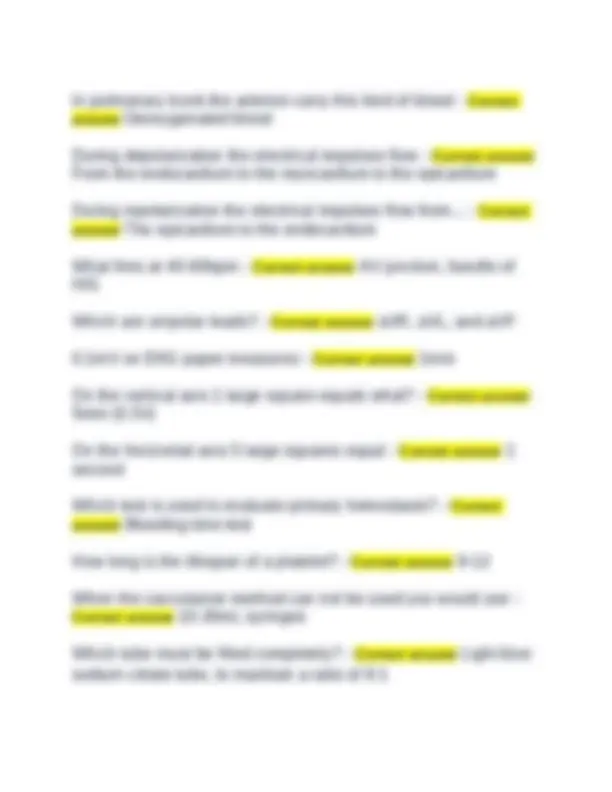


Study with the several resources on Docsity

Earn points by helping other students or get them with a premium plan


Prepare for your exams
Study with the several resources on Docsity

Earn points to download
Earn points by helping other students or get them with a premium plan
Community
Ask the community for help and clear up your study doubts
Discover the best universities in your country according to Docsity users
Free resources
Download our free guides on studying techniques, anxiety management strategies, and thesis advice from Docsity tutors
Specifically for students from the MA program in Job Corps. This is a study guide for the NHA Certification as a Clinical Medical Assistant. Guide covers phlebotomy, EKGs, anatomy and physiology, clinical skills, federal laws and programs (e.g. HIPPA), and treatment of patients.
Typology: Exams
1 / 27

This page cannot be seen from the preview
Don't miss anything!




















CC - Correct answer Chief Complaint Segment - Correct answer Line between two waveforms P Wave - Correct answer Arterial Depolarization How many 1mm boxes are in a 6 second rhythm strip? - Correct answer 30 one millimeter boxes The SA node represents which waveform on the EKG? - Correct answer Only the P wave What is the reading you can get from the RR interval? - Correct answer Ventricular Pulse What is the primary stage of Hemolysis? - Correct answer Vascular phase and platelet phase together What is Electrophoresis? - Correct answer Analyzation of the chemical components of blood, e.g. hemoglobin, serum, urine, cerebrospinal fluid based on electrical charge. Positive testing for occult blood in a stool sample turns which color? - Correct answer Turns blue on a positive test for occult blood in feces The stages of Hemostasis - Correct answer 1. Vascular, 2. Platelet Phase, 3. Coagulation Phase,
Blood vessels - Correct answer Aorta, Arteries, Arterioles, Capillaries, Venues, Veins, Superior and Inferior Vena Cavae Outer connective tissue layer of a blood vessel - Correct answer Tunica Adventitia Inner endothelial tissue of a blood vessel - Correct answer Tunica Intima The inner smooth layer of a blood vessel - Correct answer Tunica tunica media The standards of right and wrong in a medical setting - Correct answer Code of Ethics What do you find in capillaries? - Correct answer A mixture of venous and arterial blood is found The average adult has how many liters of blood? - Correct answer 5-6 Liters What is the percentage of water in the blood? - Correct answer 92% Percentage of plasma in the blood? - Correct answer 55% Percentage of formed elements in the blood? - Correct answer 45% 99% of formed elements in the blood - Correct answer RBC,s or Erythrocytes Where do you find hemoglobin? - Correct answer RBC,s Where do all blood cells originate? - Correct answer Bone marrow
Test used to evaluate the intrinsic pathway and monitor heparin therapy - Correct answer APTT also know as PTT Test used to evaluate the extrinsic pathway and also used to monitor warfarin therapy - Correct answer PT Fibrinolysis - Correct answer Breakdown and removal of a clot Converts the temporary platelet plug in a stable fibrin clot - Correct answer Coagulation Phase 2nd choice vein for venipuncture and most often the only one palatable in an obese Pt. - Correct answer Cephalic vein Antiseptics used in Phlebotomy - Correct answer 70% isopropyl alcohol pads most common, provolone - iodine for BC,s and Chlorhexidine gluconate for patients that are allergic to Betadine/ Iodine Length of needle commonly used in venipuncture - Correct answer 1 inch (up to 1.5") Average gauge of needle used for drawing blood - Correct answer 21- Gauge of needle that can cause hemolysis - Correct answer smaller than 23 gauge 3 skills of the phlebotomist - Correct answer Social, clerical, technical Analytical errors during collection of blood - Correct answer Extended tourniquet time, hemolysis, wrong order of draw, failure to invert tubes, faulty technique under filling tubes
Analytical errors before collection of blood - Correct answer Patient misidentification, improper time, wrong tubes, not fasting, exercise (Cortisol levels), Pt. Posture, Poor coordination with other treatments, improper site prep, medication interference Analytical errors After collection of blood - Correct answer Failure to separate serum from cell (Glycolisis), improper use of serum separator (Not inverting tubes or not spinning tubes), delays in processing, exposure to light, improper storage conditions, dimming clots Fistula - Correct answer Permanent surgical connection between an artery and a vein, never used for venipuncture Edima - Correct answer Accumulation of fluid in tissue Thrombophlebitis - Correct answer Inflammation of a blood clot formation Explanation of Hemoconcentration - Correct answer The increase in proportion of formed elements to plasma caused by leaving on the tourniquet for more than two minutes Consequence of insufficient pressure applied after withdrawal of a needle - Correct answer Thrombus Additives in a green top tube - Correct answer Heparin, sodium, lithium, ammonium Why is the green top tube never used for hematology? - Correct answer Green tops additive heparin interferes with the Wright's stained blood test Common tests for the lavender EDTA tube - Correct answer CBC, differential or diff, ESR, sickle cell screening
Where on the foot is the dermal puncture made on patients less than 1 years old? - Correct answer The medial and lateral areas of the plantar surface of the foot Dermal puncture is made in - Correct answer The fleshy portion of the finger slightly to the side of the center perpendicular to the lines of the fingerprints what will occur if you puncture the heel too deep? More than 2mm
The physical examination of urine consists of - Correct answer Color, Clarity, Specific gravity A low power microscope has a magnifying power of - Correct answer 100X Oil immersion objectives on the microscope reach a maximal magnification of - Correct answer 1000X This objective of the microscope is used for observing bacteria, WBC differential count and RBC morphology - Correct answer Oil immersion Eyepiece of the microscope - Correct answer Ocular lens Focal length is? - Correct answer The distance of the object to be examined to the center of the lens Meter to inches - Correct answer 39. High power objective on a microscope magnification - Correct answer 400X 1000 meter are equal to - Correct answer 1km 1mm to inches - Correct answer 0. 0.3 meter of tubing is how many inches - Correct answer 12 inches 1kg is how many pounds - Correct answer 2.2 pounds Abbreviation of microliter - Correct answer ul Abbreviation for decimeter - Correct answer dm
Physical examination of urine consists of - Correct answer Volume (Adequate for testing, observing color, appearance, odor, and specific gravity What amount of urine must you have to be sufficient for analysis?
A positive urine nitrate test is an indication for - Correct answer A significant number of bacteria are present What color is a test positive for in nitrate in urine - Correct answer Pink The copper reaction test us used for what? - Correct answer Screening for glucose in urine The presence of leukocytes in urine is an indicator for what? - Correct answer Bacteriuria or UTI Urine screening for UCG or hCG - Correct answer Pregnancy test HIPAA is for? - Correct answer Patient confidentiality The four elements of negligence are - Correct answer 1. Duty of care, 2.Derelict: Breach of duty, 3.Direct cause, 4.Damage Tort - Correct answer Wrongful act that results in injury to one person or another Examples of A Tort - Correct answer Battery, invasion of privacy, and defamation of character Defamation of character by written statement is considered - Correct answer Libel Consists of injury to another person's reputation, name, or character through spoken (Slander) or written (Libel) - Correct answer Defamation of character Unprivileged touching - Correct answer Battery
When taking axillary temperature how long should it be taken - Correct answer 5-10 mins or as required by office policy Pulse is taken where and how long - Correct answer Radial for 30secs x2, it tachy or brady take it for 1 minute Explain blood pressure - Correct answer Measurement of amount of force blood excretes on peripheral artery walls BP cuffs too short and narrow can give a false reading of what? - Correct answer Hypertension If the brachial artery is far below the heart level the BP reading can be - Correct answer Falsely high readings While taking BP the deflation rate is - Correct answer 2-3mm Hg Taking BP hearing two consecutive beats gives which reading - Correct answer Systolic The disappearance point whilst taking BP is usually what? - Correct answer A few mm Hg below the muffling point which marks the diastolic pressure How long should the arm rest between re-inflating the cuff during BP taking - Correct answer 1-2 minutes Repetitive inflation of BP cuff can result in - Correct answer Venous congestion Venous caused by repetitive inflation of BP can lead to - Correct answer Artificially low systolic and high diastolic reading Anthropometric measurements - Correct answer BMI and growth development in infants, children, and adults
The four principals of physical examination - Correct answer Inspection, palpation, percussion, auscultation The position used for most physical examinations, Pt. lays on back legs extended - Correct answer Horizontal recumbent position Patient laying on back with knees flexed, soles of feet on bed - Correct answer Dorsal recumbent This position is used to promote drainage or ease breathing - Correct answer Fowler's Prone position is used for - Correct answer Used to examine back and spine Patient lays on his/her stomach with head turned to one side for comfort - Correct answer Prone position Patient is on left side with the right knee flexed against abdomen - Correct answer Sim's Position Patients with leg injuries or arthritis can not assume this position - Correct answer Sim's This position is usually used for rectal and vaginal examination - Correct answer Knee Chest position is used for? Never leave the patient alone in the room when he/she is in this position - Correct answer Knee Chest This position is used for surgical procedures for the pelvis and abdomen. Also used for shock treatment - Correct answer Trendelenburg
What is the least expensive and most available disinfectant for surfaces - Correct answer 1:10 bleach solution Boiling water in today's medical environment is limited to items that - Correct answer Will not be used in invasive procedures, will not be interested inside the body nor in sterile procedures Define surgical asepsis - Correct answer All microbial life, pathogen, and non pathogens are destroyed What is used at 250-254f, 15 pounds of pressure for 20- minutes? - Correct answer Autoclave Used on instruments that easily corrode - Correct answer Dry heat sterilization What is the most important means of preventing the spread of infections? - Correct answer Handwashing PPE includes - Correct answer Mask, goggles, face shields, respirator What defines standard precautions - Correct answer All patients are presumed to be infected with blood borne pathogens This is an infection control method designed to prevent direct contact with blood or other body fluids - Correct answer Standard precautions This replaces universal precautions and body substance isolation
This is the second tier of precautions when patient is contagious - Correct answer Transmission based precautions Define contact precautions - Correct answer Reducing the risk of transmission of microorganisms direct or indirect Special air handling and ventilation are required to prevent - Correct answer Airborne diseases under airborne precautions This is an emerging and important problem in the health care field
Heart sounds produced by closure of the valves - Correct answer Murmurs Caused by diseases of the valves or other structural abnormalities
Digitalis, dopamine, epinephrine - Correct answer Drugs that increase the contractility of the heart Depolarization flows from - Correct answer Endocardium to the myocardium to the epicardium Results in myocardial relaxation - Correct answer Repolarization Found in the upper posterior portion of the right atrial wall below the vena cava opening - Correct answer SA node Consists of anterior, middle and posterior divisions that distribute electrical impulses by SA to Av node - Correct answer Internodal pathway Located at the posterior septal wall of the right atrium just above the tricuspid valve - Correct answer AV node Found at the superior portion of the inter ventricular septum, pathway that leads out of the SA node - Correct answer Bundle of HIS Located within the ventricular endocardium, consists of small conduction fibers - Correct answer Purkinjie fibers This fires at 20-40 beats per minute - Correct answer Purkinjie fibers This has a 1/10th of a delay to allow blood to flow from atria to ventricles - Correct answer AV node Has an intrinsic firing rate of 40-60bpm - Correct answer Bundle of HIS